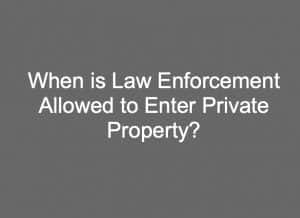On Monday, the Minnesota Court of Appeals reversed a driver’s license revocation from one of our very own cases in LaClair v. Commissioner of Public Safety. In ruling in our favor, the court of appeals touched on a popular topic: when is law enforcement allowed to enter private property? Constitutionally protected areas, such as a home and its surrounding areas know as curtilage, require a warrant or an exception to the warrant requirement before cops can enter.
There is an implied license, however, for the general public and law enforcement, to approach the front door of a home and knock. But, this implied license is limited in time and purpose as determined by social norms. The court cited a United States Supreme Court case, Florida v. Jardines in stating “Complying with the terms of that traditional invitation does not require fine-grained legal knowledge; it is generally managed without incident by the Nation’s Girl Scouts and trick-or-treaters.” The court reasoned that an implied license does not extend to all hours of the night. Unless there is an emergency or some proof the homeowner accepts visitors at all hours.
In LaClair, an officer was patrolling a neighborhood and noticed a vehicle with its headlights on parked in a driveway in front of a home. The cop drove by again an hour later and saw the headlights were still on. The cop parked at the end of the driveway blocking a path for the car to exit. He activated his squad’s spotlight and approached the home in full police uniform. As he was walking up the driveway, he noticed a puddle, which he suspected was urine, and footprints leading toward the vehicle. He went to the passenger side of the vehicle, turned on his flashlight, and saw a person slumped over the console while sitting in the driver’s seat. The officer walked over to the driver’s side of the vehicle and opened the door without first knocking or announcing his presence. The person admitted to having too much to drink and was later arrested for DWI.
In sustaining the driver’s license revocation, the district court reasoned that the officer did not block, or seize, the driver before the initial approach onto the driveway. Therefore, no reasonable suspicion of criminal activity was necessary. Then, the district court explained that the driveway is a place an ordinary visitor would be expected to go to notify a homeowner that their headlights were still on. The court of appeals disagreed on this issue. It stressed that the district court did not consider the officer entered the driveway at 1:00 a.m. for a non-emergency situation. There was no proof that an emergency existed. There was no imminent danger to anyone. The officer could not even see anyone in the vehicle until he was already on constitutionally protected curtilage. The court of appeals determined these were not circumstances where an ordinary citizen would approach a home in the middle of the night.
Robert H. Ambrose is a criminal defense attorney and DWI attorney in Minnesota. Super Lawyers named him a Rising Star for the past five years; and the National Trial Lawyer’s Organization named him a Top 40 Under 40 Trial Lawyer the past seven years. He is an adjunct professor at the University of Minnesota Law School. DWI Lawyer Woodbury MN; Criminal Defense Lawyer Minnesota; and DWI Attorney Twin Cities.
[column parallax_bg=”disabled” parallax_bg_inertia=”-0.2″ extended=”” extended_padding=”1″ background_color=”” background_image=”” background_repeat=”” background_position=”” background_size=”auto” background_attachment=”” hide_bg_lowres=”” background_video=”” vertical_padding_top=”0″ vertical_padding_bottom=”0″ more_link=”” more_text=”” left_border=”transparent” class=”” id=”” title=”” title_type=”single” animation=”none” width=”1/1″ last=”true”]
[text_divider type=”double”]
REQUEST A FREE CONSULTATION
[/text_divider]
[column_1 width=”1/1″ last=”true” title=”” title_type=”single” animation=”none” implicit=”true”]
[contact-form-7 id=”9392″ title=”FREE REQUEST FORM”]
[/contact-form-7]
[/column_1]
[blank h=”30″]
[/blank]

